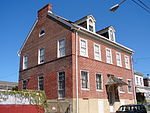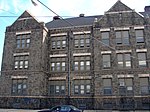Erie–Torresdale station
Railway stations in PhiladelphiaRailway stations in the United States opened in 1922SEPTA Market-Frankford Line stations

Erie–Torresdale station is an elevated rapid transit station in Philadelphia, Pennsylvania, served by the SEPTA Market–Frankford Line. It is located at the intersection of Kensington, Erie, and Torresdale avenues in the Juniata neighborhood of Northeast Philadelphia. The station is also served by SEPTA City Bus routes 3 and 56, both of which are former trolley lines.
Excerpt from the Wikipedia article Erie–Torresdale station (License: CC BY-SA 3.0, Authors, Images).Erie–Torresdale station
Kensington Avenue, Philadelphia
Geographical coordinates (GPS) Address External links Nearby Places Show on map
Geographical coordinates (GPS)
| Latitude | Longitude |
|---|---|
| N 40.006 ° | E -75.0961 ° |
Address
Erie-Torresdale
Kensington Avenue
19124 Philadelphia
Pennsylvania, United States
Open on Google Maps







